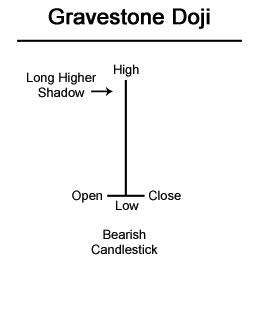Gravestone Doji Candlestick Pattern

The Gravestone Doji is viewed as a bearish reversal candlestick pattern that mainly occurs at the top of uptrends.

The Gravestone Doji is created when the open, low, and close are the same or about the same price (Where the open, low, and close are exactly the same price is quite rare). The most important part of the Graveston Doji is the long upper shadow.
The long upper shadow is generally interpreted by technicians as meaning that the market is testing to find where supply and potential resistance is located.
The construction of the Gravestone Doji pattern occurs when bulls are able to press prices upward. However, an area of resistance is found at the high of the day and selling pressure is able to push prices back down to the opening price. Therefore, the bullish advance upward was entirely rejected by the bears.

In the chart above of Altria (MO) stock, the market began the day testing to find where support would enter the market. Altria eventually found resistance at the high of the day, and subsequently fell back to the opening’s price.
The Gravestone Doji is a helpful Candlestick reversal pattern to help traders visually see where resistance and supply is likely located. After an uptrend, the Gravestone Doji can signal to traders that the uptrend could be over and that long positions could potentially be exited. But other indicators should be used in conjunction with the Gravestone Doji pattern to determine a potential sell signal. For example, a potential trigger could be a break of the upward trendline support.
The reverse of the Gravestone Doji is the bullish Dragonfly Doji (see: Dragonfly Doji).
The information above is for informational and entertainment purposes only and does not constitute trading advice or a solicitation to buy or sell any stock, option, future, commodity, or forex product. Past performance is not necessarily an indication of future performance. Trading is inherently risky. Commodity.com shall not be liable for any special or consequential damages that result from the use of or the inability to use, the materials and information provided by this site.